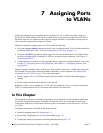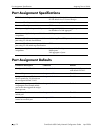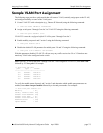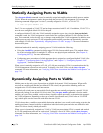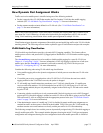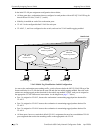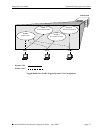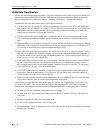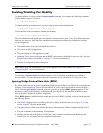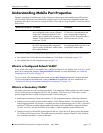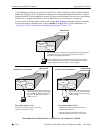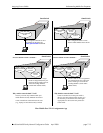
Dynamically Assigning Ports to VLANs Assigning Ports to VLANs
page 7-8 OmniSwitch 6600 Family Network Configuration Guide April 2006
VLAN Rule Classification
VLAN rule classification triggers dynamic VLAN port assignment when traffic received on a mobile port
matches the criteria defined in a VLAN rule. Different rule types are available for classifying different
types of network device traffic (see Chapter 8, “Defining VLAN Rules,” for more information).
Consider the following items when using VLAN rule classification:
• A mobile port can only join one VLAN at a time unless the port receives IP or IPX traffic and IP and
IPX protocol rules are defined. For example, if VLAN 10 has an IP protocol rule and VLAN 20 has an
IPX protocol rule and a mobile port has a device connected to it that sends both types of traffic, the
mobile port will join both VLAN 10 and VLAN 20.
• The first packet received on a mobile port is compared to all VLAN rules configured on the switch.
The VLAN with the highest precedence rule that matches packet contents is assigned to the mobile
port.
• When a mobile port is dynamically assigned to a VLAN, all other traffic received on the port is filtered
on the new VLAN. Only traffic that matched the VLAN rule is bridged on the new VLAN and no traf-
fic is carried on the mobile port’s original configured default VLAN.
• Any traffic received on these ports that does not match any VLAN rules, is carried on default VLAN 1
until the port is dynamically assigned to another VLAN. Use the vlan port default vlan command to
prevent the default VLAN from carrying non-matching traffic (see “Understanding Mobile Port Prop-
erties” on page 7-13 for more information).
• Connecting a hub to a mobile port is only recommended if the hub is going to receive IP and IPX traf-
fic and VLANs are configured with the appropriate protocol rules or if the hub is going to receive
802.1Q tagged packets and VLAN mobile tagging is enabled on switch VLANs (see “VLAN Mobile
Tag Classification” on page 7-5 for more information).
• If a VLAN is administratively disabled, dynamic mobile port assignments are retained but traffic on
these ports is filtered for the disabled VLAN. However, VLAN rules remain active and continue to
classify mobile port traffic for VLAN membership.
• When a VLAN is deleted from the switch configuration, all rules defined for that VLAN are automati-
cally removed and any static or dynamic port assignments are dropped.
The following example illustrates how mobile ports are dynamically assigned using VLAN rules to clas-
sify mobile port traffic. This example includes diagrams showing the initial VLAN port assignment
configuration and a diagram showing how the configuration looks after mobile port traffic is classified.
In the initial VLAN port assignment configuration shown on page 7-9,
• All three ports have workstations that belong to three different IP subnets (130.0.0.0, 138.0.0.0, and
140.0.0.0).
• Mobility is enabled on each of the workstation ports.
• VLAN 1 is the configured default VLAN for each port.
• Three additional VLANs are configured on the switch, each one has an IP network address rule defined
for one of the IP subnets.




